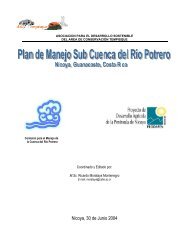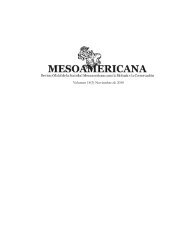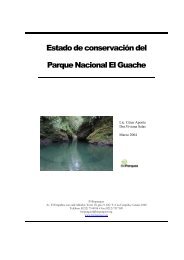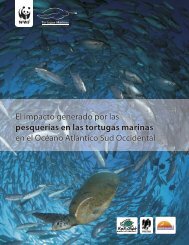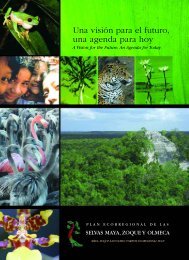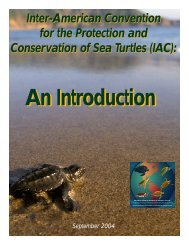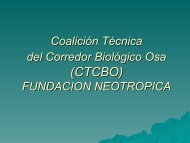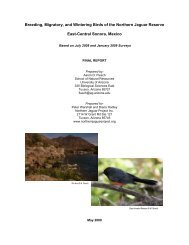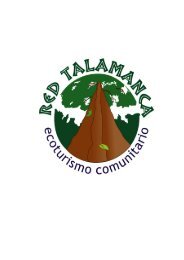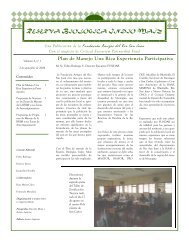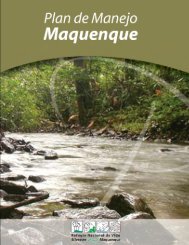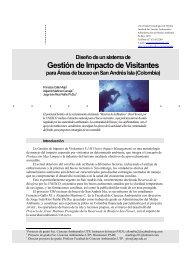1994-2006 - Eco-Index
1994-2006 - Eco-Index
1994-2006 - Eco-Index
You also want an ePaper? Increase the reach of your titles
YUMPU automatically turns print PDFs into web optimized ePapers that Google loves.
NICARAGUA-COSTA RICA<br />
In Nicaragua and Costa Rica, great extensions of pristine<br />
and partly intervened forests are threatened by the fast logging<br />
that happens as much in the buffer zone of the Indio-<br />
Maíz Biological Reserve as in northern Costa Rica. In these<br />
areas, the forest industry takes advantage of the absence of<br />
policy for an integral development and mechanisms that<br />
warrant the sustainable management of forest resources.<br />
The environmental<br />
partnership between<br />
Costa Rica and Nicaragua<br />
is the result of various<br />
workshops held to build<br />
an integrated model that<br />
initiated in the eighties<br />
with the SI-A-PAZ initiative<br />
(International System of<br />
Protected Areas for<br />
Peace). In April 1999, the<br />
Biosphere Reserve of<br />
Southeast Nicaragua was<br />
created.<br />
In 2000 and 2001, The United Nations Program for<br />
Development (UNPD) facilitated bi-national meetings<br />
amongst Nicaraguan and Costa Rican institutions, establishing<br />
a working network of the environmental, academic, cultural<br />
and media sectors from both countries. Since 2001, the<br />
Mesoamerican Biological Corridor has supported bi-national<br />
collaborative experiences originated since the SI-A-PAZ<br />
process, which led to the identification of the El Castillo-San<br />
Juan-La Selva Biological Corridor, where the great green<br />
macaw, flagship species for these territories, thrives and<br />
reproduces.<br />
The bi-national campaign “Save the Great Green Macaw”<br />
is being implemented since 2001 together with Fundación<br />
del Río and the Tropical Science Center, in Nicaragua and<br />
Costa Rica respectively. This bi-national experience teaches<br />
us that Nicaraguan and Costa Rican protected areas maintain<br />
a clear biological and social relationship within the San Juan-<br />
La Selva basin. In 2002, we worked on building these links.<br />
By mid 2002, we decided to strengthen the identification of<br />
stakeholders by the way of specific actions. Such was the<br />
case, for example, of the crystallization on the topic of the<br />
Great Green Macaw: eleven workshops about the biology<br />
and conservation of the great green macaw were held in<br />
Nicaragua and five bi-national festivals were organized. This<br />
partnership produced many outreach in the buffer zone of<br />
Indio-Maíz Biological Reserve. This process led to the creation<br />
of the Bi-national Commission of the El Castillo-San<br />
Juan-La Selva Biological Corridor in November 2002, which<br />
is integrated by government agencies, local governments<br />
and NGOs from both countries, with the aim to develop binational<br />
actions that had been conducted on an informal<br />
basis until then.<br />
Our endeavour to conserve the metapopulation of great<br />
green macaws and the habitat that this magnificent bird<br />
represents is clearly oriented towards the strengthening of<br />
collaborative links between Nicaragua and Costa Rica.<br />
Fideicomiso Maquenque<br />
Maquenque Trust<br />
Para fortalecer los componentes operativos y programáticos<br />
del Refugio Nacional de Vida Silvestre Mixto Maquenque<br />
y del Corredor Biológico San Juan-La Selva, canalizamos<br />
donaciones mediante el Fideicomiso Maquenque. Esto nos<br />
permitirá asegurar la protección de la lapa verde y su hábitat<br />
a largo plazo.<br />
Visítenos en www.maquenque.net.<br />
In order to strengthen the operative and programmatic<br />
components of Maquenque National Wildlife Refuge and<br />
San Juan-La Selva Biological Corridor, we channel donations<br />
through the Maquenque Trust. This will allow us to assure<br />
the protection of the great green macaws and their habitat<br />
on the long term.<br />
Visit us at www.maquenque.net.<br />
10




